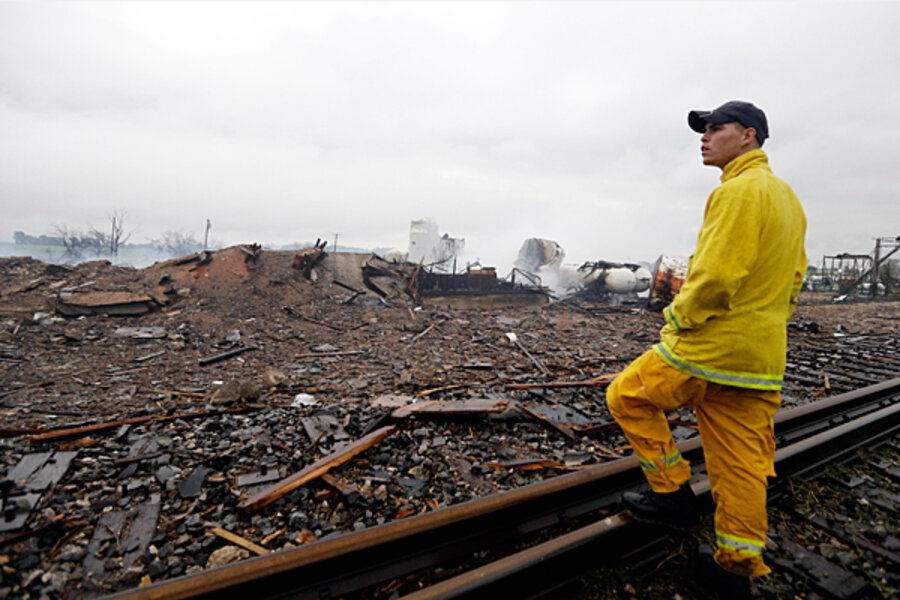Texas fertilizer plant: Why was the blast so enormous?
Loading...
Rescuers are combing through leveled homes and apartment buildings in the hunt for survivors following Wednesday night's fire and explosion at a small fertilizer and grain-storage company near Waco, Texas.
Initial estimates put the number of fatalities at up to 15, with more than 160 people injured. The blast had enough energy to trip US Geological Survey seismographs as a magnitude 2.1 quake.
How did such a powerful explosion happen?
The plant in question, West Fertilizer Co., is said to have had some 54,000 pounds of anhydrous ammonia on-site, a key ingredient in making ammonium nitrate, which is widely used as fertilizer. It's also used in cold packs, as rocket fuel, and as an explosive.
The fire would have affected each compound in different ways, specialists say.
Typically, anhydrous ammonia, a gas, is stored in tanks with relief valves so that as hot weather heats the gas and it expands, the valves vent some of the gas to prevent it from bursting its tank, explains Matt Pearson, fertilizer containment and certification specialist with the Office of Indiana State Chemist & Seed Commissioner, based at Purdue University in West Lafayette, Ind.
The explosion could have occurred in part as heat from the fire caused the gas to expand far faster than relief valves could vent it. Direct ignition of the gas is unlikely, Mr. Pearson suggests, because the gas burns only at very high temperatures – about 1,200 degrees F.
Ammonium nitrate may be the more likely candidate in the explosion.
In small quantities, the white pellets won't detonate, notes Ronald Willey, a chemical engineering professor at Northeastern University in Boston. Many drugstore cold packs use the compound because, when water is also put in the packs, the mixture absorbs heat from its surroundings.
But the compound begins to decompose into nitrous oxide and water when heated to temperatures above 150 degrees F. – a process that itself releases heat. If temperatures rise to about 400 degrees F. or higher, as in a fire, decomposition can become explosive.
Indeed, the largest industrial accident in US history involved 2,300 tons of ammonium nitrate tucked in the hold of a cargo ship in Texas City in 1947. The ship was to deliver the fertilizer to Europe. A fire broke out onboard, and after about an hour of fruitless efforts to battle the blaze, the ammonium nitrate exploded.
The blast triggered more explosions and fires, including a blast on a nearby ship that also was carrying ammonium nitrate. The death toll has been estimated at 581 or more.
Shortly after the terrorist attacks on the World Trade Center and Pentagon in 2001, a fertilizer factory in Toulouse, France, exploded. The blast involved between 200 and 300 tons of ammonium nitrate pellets. Some 31 people died and more than 2,400 were injured. The blast left an enormous crater – and a cleanup bill that reportedly reached 3.2 billion euros.
In the case of the explosion in the small community of West, the plant itself was destroyed, along with up to 75 homes, a middle school, and a nursing home in a four-block area nearby.
West Fertilizer Co. is bounded on the east by farmland. But to the west, a single set of railroad tracks is all that separated the facility from homes and the middle school.
Records from the US Environmental Protection Agency show that in 2006, the agency fined West Fertilizer Co. for having an inadequate plan to deal with risks at the site, according local press reports. The same year, the Texas Commission on Environmental Quality issued a citation to the company for failing to apply for or qualify for a permit, after residents nearby complained about strong ammonia odors.
Following Wednesday's explosion, the US Chemical Safety Board and the Bureau of Alcohol, Tobacco, Firearms and Explosives have sent investigators to determine a cause.








